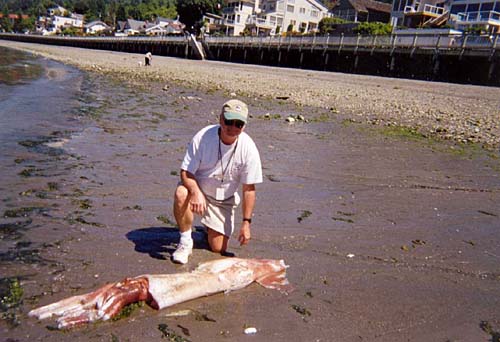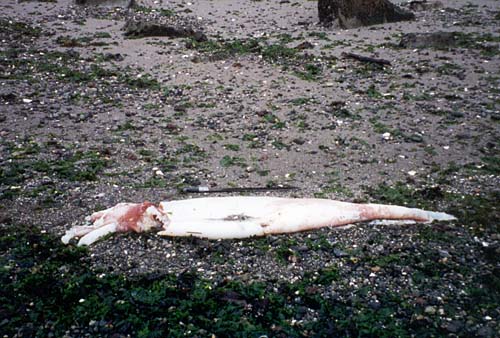
 |
| Home | What's New? | Cephalopod Species | Cephalopod Articles | Lessons | Bookstore | Resources | About TCP | FAQs |
Records of the Robust Clubhook squid Moroteuthis robusta in Puget Sound, WA, USA<< Cephalopod Articles | By Dr. Roland Anderson, The Seattle AquariumFirst published in Of Sea and Shore (1996), 19:111-113, this article is published with the permission of its editor and has been updated (2002).  The robust clubhook squid Moroteuthis robusta is a large squid in the family Onychoteuthidae. It may reach a total length (TL) of over 4 m, with a mantle length (ML) of more than 2 m (Verrill, 1876); more commonly the ML is about 1 m (Hochberg and Fields, 1980). M. robusta is distinguished from other squid of the North Pacific by presence of 2 rows of sharp hooks on the tentacle clubs, by the length of its fins, the fleshy longitudinal ridges on its body, and its large size (Hochberg, 1987). Berry (1912) called it the largest species of cephalopod in the North Pacific, but he was most certainly wrong. The giant squid Architeuthis have been reported in the North Pacific (Akimushkin, 1965) and the giant Pacific octopus Enteroctopus dofleini has been reported to 272 kg with a 10 m arm span in the same area (High, 1976). The robust clubhook squid Moroteuthis robusta is a large squid in the family Onychoteuthidae. It may reach a total length (TL) of over 4 m, with a mantle length (ML) of more than 2 m (Verrill, 1876); more commonly the ML is about 1 m (Hochberg and Fields, 1980). M. robusta is distinguished from other squid of the North Pacific by presence of 2 rows of sharp hooks on the tentacle clubs, by the length of its fins, the fleshy longitudinal ridges on its body, and its large size (Hochberg, 1987). Berry (1912) called it the largest species of cephalopod in the North Pacific, but he was most certainly wrong. The giant squid Architeuthis have been reported in the North Pacific (Akimushkin, 1965) and the giant Pacific octopus Enteroctopus dofleini has been reported to 272 kg with a 10 m arm span in the same area (High, 1976).
Little is known of the natural history of M. robusta other than its distribution. It has been trawled in coastal waters on both sides of the North Pacific from depths of 100- 600 m (Hochberg and Fields, 1980). It has been reported from Japan (Okutani et al, 1987), the Kuril Islands (Akimushkin, 1965), Alaska (Berry, 1912), Vancouver Island (Pattie, 1968), and along the Pacific Coast to southern California (Phillips, 1961; Van Hyning and Magill, 1964; Hochberg, 1974; Anderson, 1978). Two underwater sightings have been reported by scuba divers in California at Monterey and Santa Barbara (Phillips, 1961; Hauser, 1987). The stomach of a trawled specimen in California contained the heart urchin Brisaster latifrons and the floating siphonophore Velella velella (Smith, 1963). In turn, it is an important prey species in the diet of sperm whales (Robbins et al, 1937; Pike, 1950; Rice, 1978). Although growth stages have been described (Tsuchiya and Okutani, 1991), nothing is known of its life cycle. Although M. robusta is a coastal species it would not seem likely it would enter Puget Sound (Washington State, USA). Puget Sound is an estuary, a fjord carved by glaciers. Shallow sills (50 m deep) are present at the entrances to its major basins, which are more than 300 m deep. Major rivers enter the Sound, which contribute to lowered salinity, almost always 28 parts per thousand at the Seattle Aquarium, compared to the 35 parts per thousand of oceanic water; most squid are stenohaline and are sensitive to brackish water (Hendrix, et al, 1981). The temperature of Puget Sound ranges from 6-13 C at the Seattle Aquarium, which is certainly warmer than the temperature of the North Pacific Ocean which off the Washington coast at 250 m is 7.0 C (Landry and Hickey, 1989). A number of areas in the Sound are polluted, notably with sediments contaminated by heavy metals and toxic organics (Puget Sound Water Quality Authority, 1989). Puget Sound is a major population center, with about 2 million people living on its shores producing concomitant water traffic and toxins. In spite of these apparently inappropriate conditions, M. robusta has been repeatedly reported in the Puget Sound area. Reports of M. robusta around Puget Sound come from many sources (see Table 1). Three specimens have been taken to the Seattle Aquarium. Others were reported to the Aquarium anecdotally, with photographs of some of them made available to aquarium staff. A number were reported or were brought for identification or donation to the University of Washington's Friday Harbor Laboratories on San Juan Island or to Western Washington University. One was taken to a Seattle seafood market. One was seen underwater by a commercial scuba diver harvesting sea cucumbers who reported it to the Aquarium. Some were reported in the media. In many cases the exact dates could not be remembered by the people reporting the squid occurrence other than the year and time of year. Several of the stranded squid were taken to marine labs where they were examined in detail. M. robusta have been caught in Washington by commercial fishermen incidental to the gill net catch of sockeye salmon, Oncorhynchus nerka (Alan Kohn, University of Washington, pers. comm.). Because of this association the squid may be following sockeye salmon returning to Puget Sound in the summer. Four other species of salmon enter to spawn in rivers at different times of the year, but the squid have not been reported to be associated with these other species. The differences in water quality, temperature, salinity, and depth between Puget Sound and open waters of the North Pacific Ocean may contribute to the fact that nearly all of these animals were moribund or dead. Clarke (1966) suggests that the strandings of the giant squid Architeuthis may be caused by currents or incapacitation by low salinity, and Dell (1952) suggests that Architeuthis may chase food into shallow water and be affected detrimentally. M. robusta may be carried by currents into Puget Sound and die from its lower salinity. M. robusta also may be following prey items into Puget Sound and may not be able to tolerate the improper water conditions there. The fact that most of these squid were found during the summer may be because more people use the beaches in the summer. Most of the washed up squid were partially eaten by other animals. In the dark days of winter when beaches are deserted scavengers may leave little evidence for beachcombers to see. Hochberg (1974) also reported catches of M. robusta in the summer and fall in southern California. Stranded M. robusta might also be at the end of their natural life cycle, as presumably they die after spawning like most other squids although its larvae have not been seen in the Puget Sound area (Claudia Mills, Friday Harbor Labs, pers. comm.), which indicates that they are not reproducing there and are probably not residents. Moribund (senescent) post-spawning squid may also be carried into the Sound by currents. Whatever factor or factors it is that causes these squid to enter Puget sound and die there, it gives us an opportunity to view and study these "monsters" that we wouldn't have otherwise. ACKNOWLEDGMENTS Many thanks to the staff of the University of Washington Friday Harbor Labs especially Dennis Willows, Paul Illg, Alan Kohn, and Claudia Mills for sharing their information. Ronald Shimek provided additional information on dates of squid strandings. Thanks also to William Summers of the Western Washington University for sharing the information he had on these squids. Katherine A. Krogslund of the University of Washington's Oceanography Department supplied oceanographic details of coastal waters. Jennifer A. Mather and Shawn Larson provided thoughtful comments on the manuscript. LITERATURE CITED: Akimushkin, I.I. 1965. Cephalopods of the seas of the U.S.S.R. Israel Program for Scientific Translations. Jerusalem. 223pp. Anderson, M.E. 1978. Notes on the cephalopods of Monterey Bay, California, with new records for the area. Veliger. 21:255-62. Berry, S.S. 1912. A review of the cephalopods of western North America. Bulletin of the U.S. Bureau of Fisheries. 30:269-336. Clarke, M.R. 1966. A review of the systematics and ecology of oceanic squids. Advances in Marine Biology. 4:91 300. Dell, R.K. 1952. The recent cephalopoda of New Zealand. Dominion Museum Bulletin. 16:1 157. Hauser, H. 1987. California diver bags giant squid. Skin Diver. 36(9):110 111. Hendrix, J.P. Jr., W.H. Hulet and M.J. Greenberg. 1981. Salinity tolerance and the responses to hypoosmotic stress of the bay squid Loliguncula brevis, a euryhaline cephalopod mollusc. Comparative Biochemical Physiology. 69(A):641-648. High, W.L. 1976. The giant Pacific octopus. U.S. National Marine Fisheries Service, Marine Fisheries Review. 38(9):17 22. Hochberg, F.G. 1974. Southern California records of the giant squid, Moroteuthis robusta. The Tabulata. 7(4):83 85. Hochberg, F.G. 1987. The cephalopods. In: Kozloff, E.N. Marine invertebrates of the Pacific Northwest. University of Washington Press. 511 pp. Hochberg, F.G. and W.G. Fields. 1980. Cephalopoda: the squids and octopuses. In: Intertidal invertebrates of California, R.H. Morris et al, eds. Stanford University Press. Stanford. 690pp. Landry, M.R. and B.M. Hickey. 1989. Coastal oceanography of Washington and Oregon. Elsevier Science Publication Company. Okutani, D., M. Tagawa, and H. Horikawa. 1987. Cephalopods from continental shelf and slope around Japan. Japanese Fisheries Resource Conservation Association. Tokyo. 194pp. Pattie, B.H. 1968. Notes on giant squid Moroteuthis robusta (Dall) Verrill trawled off the southwest coast of Vancouver Island, Canada. Washington Department of Fisheries Research Paper. 3:47 50. Phillips, J.B. 1961. Two unusual cephalopods taken near Monterey. California Fish and Game. 47(4):416 17. Pike, G.C. 1950. Stomach contents of whales off the coast of British Columbia. Fish. Res. Bd. Canad., Prog. Rep. Pacif. Cst. 83:27-28. Puget Sound Water Quality Authority. 1989. Puget Sound water quality management plan. Puget Sound Water Quality Authority. Seattle. 276pp. Rice, D.W. 1978. Sperm whales. In: Marine mammals. Delphine Haley, ed. Pacific Search Press. Seattle. 256pp. Robbins, L.L., F.K. Oldham and E.M.K. Geiling. 1937. The stomach contents of sperm whales caught off the west coast of British Columbia. Rep. Prov. Mus. Natur. Hist. Brit. Col., pp 19-20. Smith, A.G. 1963. More giant squids from California. California Fish and Game. 49:209-211. Tsuchiya, K. and T. Okutani. 1991. Growth stages of Moroteuthis robusta (Verrill, 1881) with the re-evaluation of the genus. Bulletin of Marine Science. 49(1-2):137-147. Van Hyning, J.M. and A.R. Magill. 1964. Occurrence of the giant squid (Moroteuthis robusta) off Oregon. Ore. Fish. Comm. Res. Briefs. 10:67-68. Verrill, A.E. 1876. Notes on gigantic cephalopods, a correction. American Journal of Science and Arts. (3) 12:236 37.
 Photo 1. The author with a Moroteuthis robusta that washed ashore in Puget Sound 20 miles south of Seattle, Washington State, USA. Photo by Vivian Gross.  Photo 2. This clubhook squid was found on a beach 10 miles north of Seattle, Washington State, USA. The knife above the squid is 27 inches long. Photo by Robert Zweibel.
| ||||||||||||||||||||||||||||||||||||||||||||||||||||||||||||||||||||||||||||||||||||||||||||||||||||||||||||||||||||||||||||||||||||||||||||||||||||||||||||||||||||||||||||||
| Home | What's New? | Cephalopod Species | Cephalopod Articles | Lessons | Resources | About TCP | FAQs | Site Map | |
 |
The Cephalopod Page (TCP), © Copyright 1995-2026, was created and is maintained by Dr. James B. Wood, Associate Director of the Waikiki Aquarium which is part of the University of Hawaii. Please see the FAQs page for cephalopod questions, Marine Invertebrates of Bermuda for information on other invertebrates, and MarineBio.org and the Census of Marine Life for general information on marine biology. |